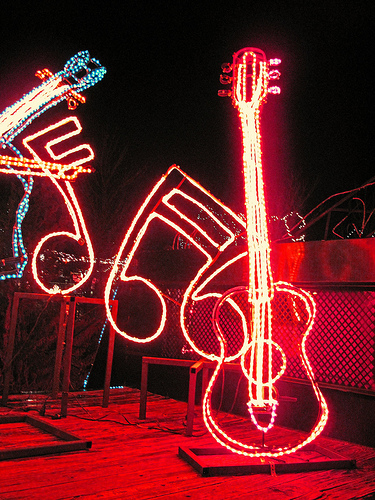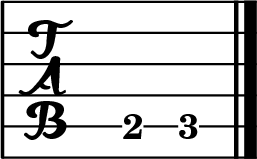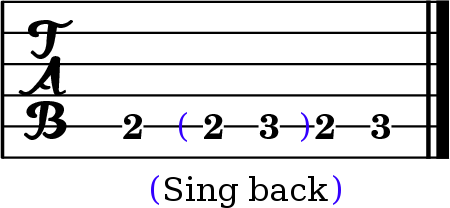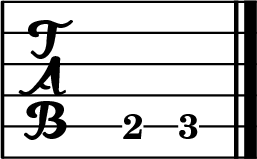 Learning to recognize intervals is an important part of any musician’s development. Guitarists who play by ear should be especially interested in developing their aural skills so that they can recognize musical elements such as intervals in harmonies and melodies. For players of improvised forms like jazz a good ear is critical for improvising as well. This article reviews intervals on the guitar and teaches a very simple method for learning and identifying them.
Learning to recognize intervals is an important part of any musician’s development. Guitarists who play by ear should be especially interested in developing their aural skills so that they can recognize musical elements such as intervals in harmonies and melodies. For players of improvised forms like jazz a good ear is critical for improvising as well. This article reviews intervals on the guitar and teaches a very simple method for learning and identifying them.
Review of Intervals
Musical intervals measure the distance between any two pitches. We identify intervals by their size and quality. We determine the size of an interval simply by counting from one pitch name to the other. For example, the interval from the sixth string, E, to the fifth string A, is a fourth: E F G A, one two three four.
The quality of an interval, whether ‘perfect’, ‘major’, ‘minor’, ‘diminished’ or ‘augmented’, is a refinement of its size. Both an interval’s size and quality make up its unique sound: a major third sounds different than a minor third.
For the guitarist, the smallest musical distance is one fret. This distance is called a semitone. We can list the most common intervals by their number of semitones or frets:
| Interval | No. of Semitones | Interval | No. of Semitones |
| Perfect Unison | 0 | Diminished 5th | 6 |
| Minor 2nd | 1 | Perfect 5th | 7 |
| Major 2nd | 2 | Minor 6th | 8 |
| Minor 3rd | 3 | Major 6th | 9 |
| Major 3rd | 4 | Minor 7th | 10 |
| Perfect 4th | 5 | Major 7th | 11 |
| Augmented 4th | 6 | Perfect Octave (8ve) | 12 |
How To Practice Intervals On The Guitar
Shortly we will review how to play some of these intervals on the guitar, but first we can take a peek at a simple method for learning how they sound. This method really involves two parts. We first want to learn how to produce an interval, and then we want to be able to recognize it.
First we play the interval we wish to learn, and sing it back. You can sing using a neutral syllable like la or ta. Below is a minor second. Play it and sing it back:

Minor Second
We repeat this play and sing back process for several different minor seconds across the guitar:

Several Different Minor Seconds
Once we are comfortable with this process of playing and singing an interval, we should sing back the interval given only the starting pitch, then check our sung interval against the guitar.

Sing back the interval given only the starting pitch.
Exercises for learning intervals
After building up a modest repertoire of intervals you can play, test your ability to recognize them:
- Ask a friend to play intervals on the guitar (or any other instrument) for you to identify. Remember: this doesn’t necessarily have to be in person!
- You can also make a recording of yourself playing random intervals to test yourself with later. You can use free software like Audacity to do this.
- Work with about ten different intervals at a time. Don’t overwhelm yourself. Be patient!
- Start with major and minor seconds, then thirds and so on until you’ve covered all the intervals in the table above.
Shapes of the Intervals On the Guitar
The above methodology for learning to recognize intervals by ear is simple and intuitive. You should be able to improve your recognition of intervals just using the fret distances in the table above. As guitarists we also need to be familiar with the different shapes of these intervals on the fretboard when played across different strings.
Getting to know these common shapes will make it easier for you to practice intervals, and help you start to connect your knowledge of them with the music you’re playing. For example, spotting the intervals in melodies and chords from the fingerings used.
Major and Minor Seconds
We have already seen that minor seconds are one fret apart in the previous example. Notice that it does not matter which string or position we play in. Two notes a fret apart equal a minor second. All of the shapes we will explore here will be movable up and down the neck in a similar way.
Major seconds are two frets apart. We can use finger combinations of 1,3 or 2,4 (pictured):

Finger combinations of 1,3 or 2,4
Major and Minor Thirds
Major and minor thirds are usually played on adjacent strings.
Note: There is a slight complication here because of the way guitars are tuned – adjacent strings have a fourth between them, except for strings 3 to 2 which are a major third apart (G to B). This means we need to adjust our shapes when they cross these strings.
For major thirds use the fingering 3,2 for strings 6-5, 5-4, 4-3, and 2-1. On strings 3-2, use the fingering 2,2:

We need to adjust our shapes when strings 3-2 come across
For minor thirds we can use the fingering 3,1 instead. On strings 3-2 use the fingerings 2,1:

For minor thirds we can use the fingering 3,1
The suggested fingerings for thirds are a useful case because you can easily compare the major and minor form on the guitar. Try playing and singing back a major third, followed by a minor one as in the following example.
You could extend this exercise chromatically (i.e. going up a string one fret at a time), or on different string combinations.
We can do the same kind of exercise with major and minor seconds:
You have probably already guessed that this ear training exercise can be applied to any interval, not just seconds and thirds!
Perfect Fourths
We will add in one more interval our repertoire of shapes and sounds: the perfect fourth, found on adjacent strings at the same fret. For the strings 3-2 we need to adjust the shape slightly:

The Perfect Fourth Interval
Continuing On
At this point we have actually covered quite a few intervals. If you are new to ear training, learning intervals up to the fourth is a good target to aim for.
Playing and singing back intervals is a simple and intuitive way to get the sound of them in your ear. As guitarists we often also start to associate a particular sound with a shape on the instrument which bridges the gap between these abstract exercises and all the music you play on your guitar. Your playing will help your ear training; and your ear training will help your playing!
As a final exercise, notice that with intervals larger than a second you can quite easily practice them harmonically: that is, intervals that sound both notes together rather than one after the other. Play the interval harmonically, then try to sing back its two pitches from the lower one to the higher one. As an example, the following exercise works on major thirds chromatically up the neck:
In this article we have reviewed common intervals up to the perfect fourth as they are played on the guitar, and presented a simple method of playing and singing them back in order to learn their sound.
Once you are comfortable with the intervals presented here, gradually add the remaining ones into your practice one or two at a time.
If you are new to ear training learning the sound of all the intervals will take time, but you should find it soon starts to increase your comfort in connecting your ear to the fretboard, and really free you up in your playing – and especially when improvising or soloing!







